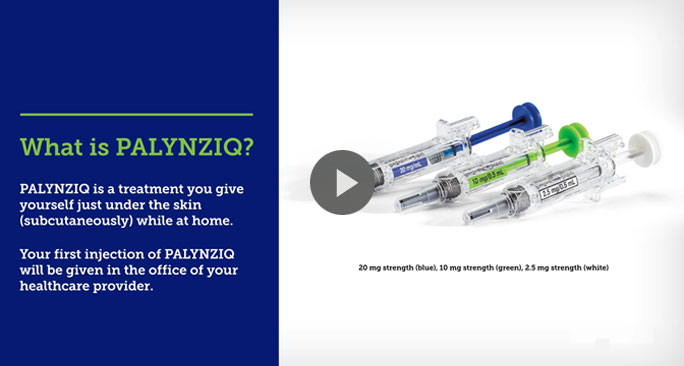Important Safety Information
What is the most important information I should know about PALYNZIQ?
PALYNZIQ can cause a severe allergic reaction (anaphylaxis) that may be life threatening and can happen any time during treatment with PALYNZIQ.
What is PALYNZIQ?
PALYNZIQ® (Pal-lin-zeek) (pegvaliase-pqpz) is a prescription medication used to lower blood levels of phenylalanine (Phe) in adults with PKU (phenylketonuria) who have uncontrolled blood Phe levels above 600 micromol/L (10 mg/dL) on their current treatment. You should discuss the potential benefits and risks of PALYNZIQ with your healthcare provider.
Severe allergic reactions are a serious but common side effect of PALYNZIQ.
- You will receive your first injection of PALYNZIQ in a healthcare setting where you will be closely watched for at least 1 hour after your injection for a severe allergic reaction
- Your healthcare provider will prescribe auto-injectable epinephrine for you, and will teach you (or your caregiver) and your observer, if needed, when and how to use it if you have a severe allergic reaction
- If you have a severe allergic reaction during treatment with PALYNZIQ, you will need to receive an injection of epinephrine immediately and get emergency medical help right away
- Your healthcare provider will decide if you (or your caregiver) are able to give the PALYNZIQ injections, recognize the signs and symptoms of a severe allergic reaction, give an injection of epinephrine, and call for emergency help, if needed
- Your healthcare provider may recommend that an adult observer (or your caregiver) be with you when you give your PALYNZIQ injection and for at least 1 hour after your injection to watch you for signs and symptoms of a severe allergic reaction and, if needed, give you an injection of epinephrine and call for emergency medical help
Stop injecting PALYNZIQ and get emergency medical care right away if you have any of the following symptoms:
- Fainting (passing out)
- Dizziness or lightheadedness
- Sudden confusion
- Trouble breathing or wheezing
- Chest discomfort or chest tightness
- Fast heart rate
- Swelling of your face, lips, eyes, or tongue
- Throat tightness
- Flushed skin
- Skin rash, itching, or raised bumps on skin
- Nausea, vomiting, or diarrhea
- Losing control of urine or stools
Keep the auto-injectable epinephrine with you at all times during treatment with PALYNZIQ. Read the Patient Information that comes with the auto-injectable epinephrine that your healthcare provider prescribes for you for more information.
If you have a severe allergic reaction, do not continue to take PALYNZIQ until you talk with your healthcare provider. Your healthcare provider will tell you if you can continue treatment with PALYNZIQ.
People taking PALYNZIQ have also experienced allergic reactions other than anaphylaxis. Talk to your healthcare provider if you experience any allergic reactions when taking PALYNZIQ.
PALYNZIQ REMS: PALYNZIQ is available only through a restricted program called the PALYNZIQ REMS (Risk Evaluation and Mitigation Strategy). Talk to your healthcare provider about the PALYNZIQ REMS and how to enroll.
What should I tell my healthcare provider BEFORE starting PALYNZIQ?
Tell your healthcare provider about all the medicines you take, including prescription or over-the-counter medicines, vitamins, and herbal supplements.
Before injecting PALYNZIQ, talk to your healthcare provider right away if you cannot or will not use auto-injectable epinephrine to treat a severe allergic reaction. If you are pregnant or plan to become pregnant while taking PALYNZIQ, talk to your healthcare provider to discuss the risks and benefits of taking PALYNZIQ during pregnancy to you and your unborn baby. If you are breastfeeding or plan to breastfeed, talk to your healthcare provider about the best way to feed your baby if you take PALYNZIQ.
Before injecting PALYNZIQ, read the Medication Guide and Instructions for Use that come with your PALYNZIQ injection.
What should I watch for AFTER starting PALYNZIQ?
PALYNZIQ may cause serious side effects, including:
- Severe allergic reactions (anaphylaxis)
- Other allergic reactions to PALYNZIQ can happen during treatment with PALYNZIQ. Contact your healthcare provider right away if you have any of the following symptoms of an allergic reaction including: rash, itching, or swelling of the face, lips, eyes, or tongue. Your healthcare provider may change your dose of PALYNZIQ, stop your treatment with PALYNZIQ for a period of time, or prescribe medicine for you to take before your PALYNZIQ injection to help reduce the symptoms of an allergic reaction
The most common side effects of PALYNZIQ include injection site reactions (such as redness, itching, pain, bruising, rash, swelling, or tenderness), joint pain, headache, skin reactions that spread and last at least 14 days (such as itching, rash, or redness), nausea, stomach pain, vomiting, cough, mouth and throat pain, itching, diarrhea, stuffy nose, feeling very tired, dizziness, anxiety, and low levels of Phe in your blood.
These are not all of the possible side effects of PALYNZIQ. Speak with your healthcare provider right away about any side effects.
Important notes
Blood Phe testing and diet
- Your healthcare provider will monitor your blood Phe levels during PALYNZIQ treatment
- Monitor the amount of protein and Phe that you eat or drink. Your healthcare provider may change the amount of protein and Phe you should have in your diet during treatment with PALYNZIQ, depending on the levels of Phe in your blood. Follow your healthcare provider’s instructions about the amount of protein and Phe you should have in your diet
Missed dose
- If a dose is missed, take your next dose as scheduled and do not take 2 doses of PALYNZIQ to make up for the missed dose
Pregnancy Surveillance Program
- There is a pregnancy surveillance program for females who take PALYNZIQ during pregnancy, or who become pregnant while receiving PALYNZIQ or within 1 month after their last dose of PALYNZIQ. The purpose of this program is to collect information about the health of you and your baby while taking PALYNZIQ. Talk to your healthcare provider about how you can take part in this program or call BioMarin at 1-866-906-6100
You may report side effects to BioMarin at 1-866-906-6100.
You are encouraged to report negative side effects of prescription drugs to the FDA. Visit www.fda.gov/medwatch, or call 1-800-FDA-1088.
Please see full Prescribing Information, including an important warning for risk of anaphylaxis, and the Medication Guide.
US-PAL-00233 0422
US-PAL-00218 0322










